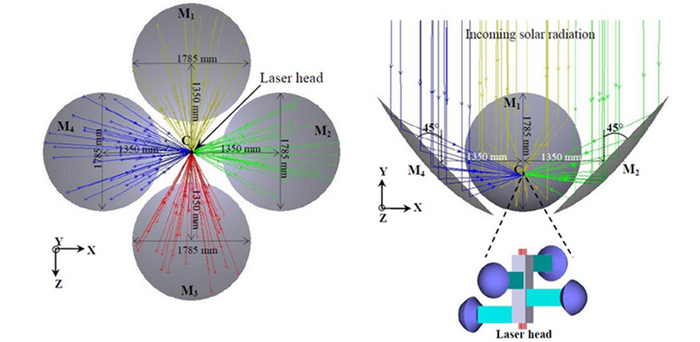The design of efficient solar cells, which harness energy to generate electricity or produce hydrogen by splitting water, has received much attention globally. Another route to harnessing abundant, free solar energy: using it as a pumping source for lasers. High-power lasers are earmarked for several applications, including deep space communication, atmospheric sensing, high-temperature material processing, and hydrogen production. But, they are often expensive and suffer from performance setbacks arising from thermal stress effects.

Credit: Boutaka, Liang, and Abdelhamid Kellou, doi 10.1117/1.JPE.12.038002.
The design of efficient solar cells, which harness energy to generate electricity or produce hydrogen by splitting water, has received much attention globally. Another route to harnessing abundant, free solar energy: using it as a pumping source for lasers. High-power lasers are earmarked for several applications, including deep space communication, atmospheric sensing, high-temperature material processing, and hydrogen production. But, they are often expensive and suffer from performance setbacks arising from thermal stress effects.
In a recent study published in the SPIE Journal of Photonics for Energy, researchers from Algeria and Portugal report a new solar-powered laser design that successfully addresses these issues. This laser has an improved laser conversion efficiency compared to those pumped with conventional sources (such as flash lamps and LEDs).
“The approach we adopted in this study allowed us to develop a powerful solar-powered laser operating in TEM00 mode, the fundamental or lowest-order mode,” explains Associate Professor Dawei Liang from Universidade Nova de Lisboa in Portugal, the corresponding author of the study. “Each of these modes (our laser sustains multiple fundamental modes) can be precisely controlled with minimal heat input to the pump cavity. This enables us to tailor the applied energy to the specific needs of an application,” he adds.
The researchers performed numerical simulations to optimize the design parameters of a TEM00-mode Nd:YAG solar laser beam. Further, they used four laser rods inside four 2V-shaped pump cavities, and pumped them with sunlight using four large off-axis parabolic mirrors with a total collection area of 10 m2.
“The laser head in our design also includes four secondary fused-silica aspheric concentrators, and four rectangular fused-silica light guides. This ensures an even distribution of the absorbed pump power within each rod and helps avoid heating damage resulting from thermal lensing and thermal stresses occurring in conventional single rod solar lasers,” elaborates Liang.
This resulted in an improved performance of the solar laser. The numerical calculations estimated a total laser power of 155.29 watts in the TEM00 mode. This resulted in a two-fold enhancement in the collection efficiency and an improvement of 1.24 times in the conversion efficiency compared to those recorded for earlier designs with similar configuration.
One of the major potential applications of this design concerns space-based solar power generation. This involves collection of solar energy in outer space, converting it to a laser beam, and sending it down to Earth where it can be utilized to generate electricity using solar cells. Since this process is not influenced by the Earth atmosphere, it is more stable and requires smaller transmission and receiving equipment than those needed in microwave power transmission.
Liang notes that while a photovoltaic-powered diode-pumped laser still has greater solar-to-laser conversion efficiency than that of a solar laser, it is much less suitable for long-term space applications. This is because a diode-pumped laser has a limited diode pump source lifetime and a more complex laser system. A solar-powered laser enjoys far greater system simplicity, and benefits from a nearly eternal and free pump source.
Overall, this study lights a way to take solar-powered lasers to new heights, with a clear blueprint for high-efficiency, space-ready solar lasers.
Read the original article by Boutaka, Liang, and Kellou, “Efficient TEM00-mode solar laser using four Nd:YAG rods/four off-axis parabolic mirrors pumping approach,” J. Photon. Energy 12(3) 038002 (2022), doi 10.1117/1.JPE.12.038002.
Journal
Journal of Photonics for Energy
DOI
10.1117/1.JPE.12.038002
Article Title
Efficient TEM00-mode solar laser using four Nd:YAG rods/four off-axis parabolic mirrors pumping approach




